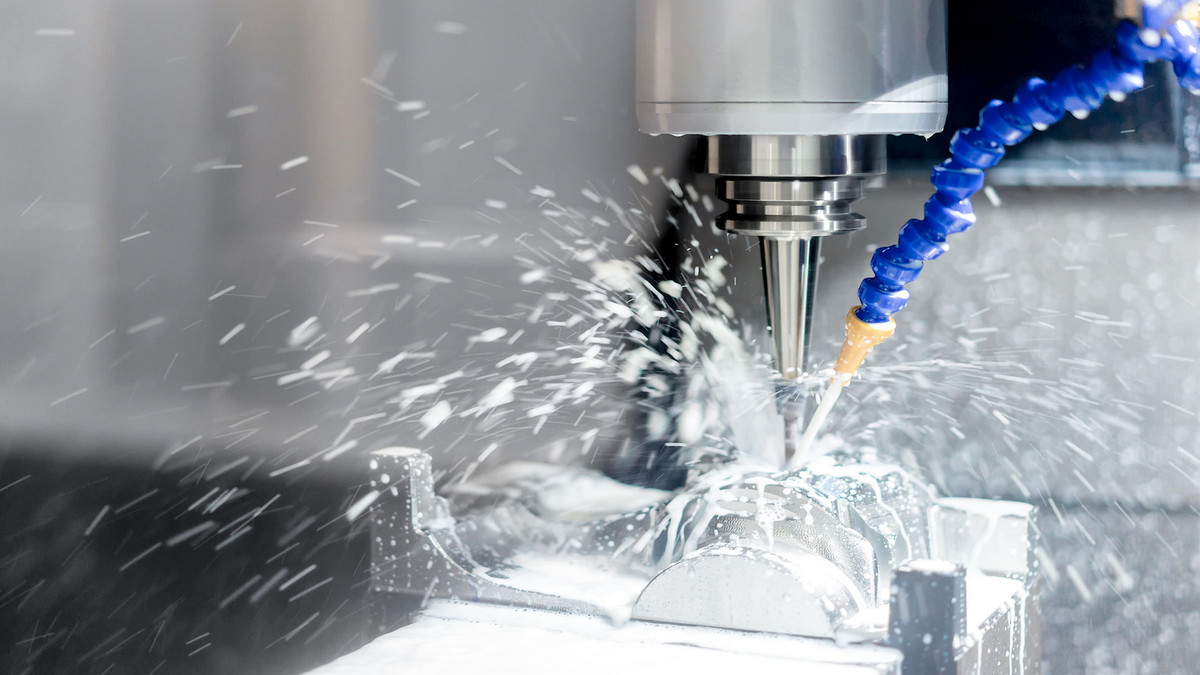Milling machines have better chip evacuation because of the nature of their configuration because gravity keeps the chips from falling. This helps improve the surface finish and prolongs the life of the tool.
The Functions of the Milling Machine:
A milling machine is a machine tool that mills a workpiece with a milling cutter. In addition to milling planes, grooves, gear teeth, threads, and spline shafts, milling machines can process more complex profiles, with higher efficiency than planers, and are used in machinery manufacturing and repair departments.
Processing state:
Lathes process cylindrical or circular rods, and milling machines process planes, holes, grooves, and curved surfaces. In principle, almost all types can be processed by lathes can be processed by milling machines. But part of the processing capacity of milling machines cannot be achieved by lathes. Although the milling machine can achieve the processing capability of the lathe, the milling machine is not as fast as the lathe in terms of processing efficiency, and the two complement each other.
CNC Milling Machine Processing Principle:
Like the CNC lathe, the CNC milling machine drives the milling machine through digital signals for processing. The milling machine moves the workpiece in the XY plane, and the Z axis rotates as the tool spindle, and the milling work is performed from top to bottom.
A machine tool that rotates a milling cutter with several blades and moves the workpiece for cutting is an economical method for small or mass production. The milling machine can fix the workpiece, and the rotary tool can generally make a 3D or 2D workpiece, which can accurately mill the workpiece in various shapes such as plane milling, curved surface milling, groove milling, and gear milling.
Difference Between Ordinary Milling Machine and CNC Milling Machine:
- CNC milling machine: It is an automatic processing device developed based on milling machines. The processing technology of the two is the same, and the structure is somewhat similar. CNC milling machines are divided into without tool magazines and with tool magazines. Among them, the CNC milling machine with tool magazine is the machining center.
- Ordinary milling machine: It is a machine tool that uses milling cutters to process various surfaces of workpieces.
Application features are different:
- CNC milling machine: With the rapid development of social production and science and technology, mechanical products are becoming more and more sophisticated and frequently modified, especially for mechanical parts required in aerospace, shipbuilding, military, and other fields, which require high precision and complex shapes, the batch is small. Processing such products require frequent modification or adjustment of devices, and ordinary machine tools or highly specialized automatic machine tools can no longer meet these requirements. To solve the above problems, a new type of CNC machine tool came into being. This new type of machine tool has the advantages of strong adaptability, high processing precision, stable processing quality, and high production efficiency. It comprehensively applies the technological achievements in many aspects such as electronic computers, automatic control, servo drive, precision measurement, and new mechanical structure, and is the development direction of CNC machine tools in the future.
- Ordinary milling machine: It has strong adaptability and good flexibility in parts processing, and can process parts with particularly complex contour shapes or difficult-to-control sizes, such as mold parts, shell parts, etc. Can process ordinary machine tools that cannot be processed or are difficult to process Parts, such as complex curve parts and three-dimensional space surface parts described by mathematical models.
What are the Milling Advantages of CNC Milling Machines?
The advantage of milling is its circular milling cutter, high metal removal rate, and it is the more economical method. It can be cut in a short time. Due to the different shapes and mechanical application methods of milling cutters, milling machines can do various milling tasks. Including plane milling, curved surface milling, groove milling, gear milling, cam milling, etc., and the form milling cutter can be used to complete the milling of complex contours at one time and cooperate with the dividing head to mill out the spiral groove. The CNC milling machine uses the Z axis as the tool spindle to rotate, and the workpiece moves in the XY plane, milling from top to bottom. No matter sample proofing or mass production, the milling machine can achieve economies of scale in a more economical and affordable processing method.
What are the Types of Milling Machine Processing?
- Vertical milling machine processing:
The cutter shaft is set in an upright position. The movement of the table is the same as that of a common milling machine, and the milling cutter has no other movement except the rotation. The rotating shaft tool head can be rotated, and the rotating shaft can be set on the vertical plane at any angle from vertical to horizontal. The rotating shaft of this kind of machine can move up and down in a short distance on the mass axis, which is beneficial to layered milling. Some vertical mills have rotary attachments or rotary tables. Milling slots or continuous milling of small-volume production parts. The cutting tools used on vertical milling machines are end mills.
- Universal milling machine processing:
The universal milling machine is the most versatile. The bed platform can not only move vertically, horizontally, and vertically, but also can rotate 45 degrees left and right in the horizontal direction. The milling cutter is installed on the mandrel. The mandrel has more than ten kinds of rotation speeds, which are matched with the feed in three directions of the bed. Therefore, a variety of milling cutters and different conditions can be used to meet the needs of the work. And the bed can be rotated, so it can mill spiral work and angled surfaces, so it is a universal milling machine.
- Horizontal milling machine processing:
This machine is primarily designed for milling large workpieces where large amounts of material are to be milled, and for accurately replicating surfaces and contours. Its working principle is to feed the milling cutter in rotation at a moderate speed on a long table with only longitudinal movement.
Advantages of Horizontal Milling Machine:
- The machine tool has good rigidity and can carry heavy load cutting.
- The spindle motor of the horizontal milling machine has high power and a wide range of speed changes, which can fully exert the tool's performance and cut at high speed.
- The wear-resistant castings are made of vanadium-titanium wear-resistant cast iron, and the important parts are made of high-quality alloy steel, which is stable and durable.
- The machine tool has a complete lubrication system.
- The horizontal milling machine can be configured with a digital display device according to user needs. This product is easy to operate and reliable in performance. Various cylindrical milling cutters, disc milling cutters, angle milling cutters, profile milling cutters, and face milling cutters can be used to process various planes, inclined surfaces, grooves, etc.
Advantages of Milling and Milling:
- It can be used in old milling machines without producing an invalid clearance movement of the screw.
- Suitable for milling the black leather surface of castings.
- The force on the teeth of the milling cutter is light at the beginning and the end is heavy, so the blade is not easy to break.
Advantages of Down Milling on a Milling Machine:
- There is less friction during processing, and the life of the milling cutter is longer.
- Easy clamping, no vibration, high precision machining surface.
- Easy to manufacture and set, suitable for long and thin workpieces.
- Feed consumes less power.
Expansion Kit Information Related to CNC Milling:
- Parts processing has strong adaptability and flexibility and can process parts with particularly complex contours or difficult-to-control sizes, such as mold parts, and shell parts.
- It can process parts that cannot be processed by ordinary machine tools or are difficult to process, such as complex curve parts described by mathematical models and three-dimensional space surface parts.
- It can process parts that need to be processed by multiple processes after one clamping and positioning.
- High machining accuracy and stable and reliable machining quality. The pulse equivalent of the numerical control device is generally 0.001mm, and the high-precision numerical control system can reach 0.1μm. In addition, numerical control machining avoids operator errors.






.png)







